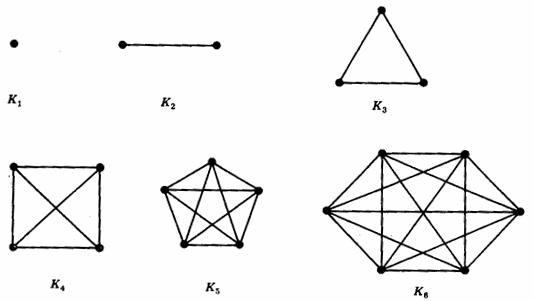A complete graph is such that every vertex is connected to every other vertex directly exactly once. If a complete graph has n vertices, it is called![]() The following graphs are all complete.
The following graphs are all complete.

A path is a route between any two vertices.
If a graph has two nodes A and B, there are two paths with one vertex, A and B, and two paths AB and BA with two vertices.
If a graph has three vertices A, B and C, there are three paths with one node, A, B and C. If the path has more than one node we can choose start and end vertices in 3*2=6 ways (AB, AC, BC, BA, CA and CB). Each of these can be a path direct from start vertex to end vertex or with an intermediate vertex, giving the other paths ACB, ABC, BAC, BCA, CBA and CAB hence 3+6+6=15 paths altogether.
In general for a graph with![]() vertices we can choose paths with one vertex in
vertices we can choose paths with one vertex in![]() different ways. and for a path with two or more vertices we can choose start and end points in
different ways. and for a path with two or more vertices we can choose start and end points in![]() ways.
ways.
We have then![]() paths with two vertices.
paths with two vertices.
We can have paths with intermediate vertices. Suppose we have one intermediate vertex. This is chosen from the![]() remaining vertices so there are
remaining vertices so there are![]() paths with three vertices.
paths with three vertices.
Suppose we have two intermediate vertices. These are chosen from the![]() remaining vertices, and since to choose the vertices in a different order determines a different path, we can choose the two intermediate vertices in
remaining vertices, and since to choose the vertices in a different order determines a different path, we can choose the two intermediate vertices in![]() different ways so there are
different ways so there are![]() different paths.
different paths.
Continuing in this way until all the vertices are chosen, giving![]() paths and adding we obtain
paths and adding we obtain![]() possible paths for a complete graph with
possible paths for a complete graph with![]() vertices.
vertices.
For![]() as before.
as before.
